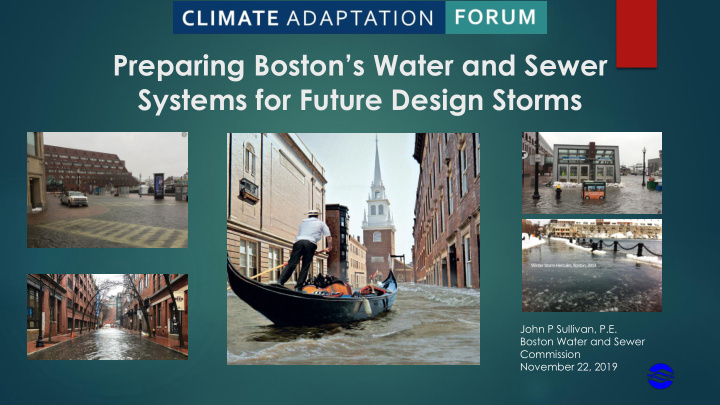



Preparing Boston’s Water and Sewer Systems for Future Design Storms John P Sullivan, P.E. Boston Water and Sewer Commission November 22, 2019
DISCUSSION TOPICS Present Condition & Upgrades to Existing Systems Improved Stormwater and Inundation Modelling Upland Control of Stormwater Coastal Stormwater Discharge Analysis Smart Sewers
STORMWATER WATERSHEDS
TIDE GATES MOUNTED ON SEA WALL
NEW TIDE GATES MT. WASHINGTON AVE
WHY ARE TIDE GATES IMPORTANT
Boston Stormwater Management Total Maximum Daily Load (2007) Phosphorus: Upper & Middle/Lower Charles River Consent Decree (2012) Update Stormwater Model Create BMP Implementation Plan Implement 3 Pilot Green Infrastructure/Low Impact Development (“GI/LID”) Projects Central Square, Audubon Circle, City Hall Plaza
GI/LID Obstacles in Boston Commission does not own land for GI/LID • Need to work with other agencies and entities Department of Public Works – Department of Transportation – Boston Parks and Recreation Department – Boston Public Schools – Boston Planning and Development Agency – • Need to work with private property owners • Need complete understanding of who is responsible for continued maintenance
Year 2060 Rain Sea Level Rise, With Storm Surge
Today’s Extreme High Tides
IMPROVED INUNDATION MODELLING Develop improved models to show extent and duration of inundation in major wet weather events Source: CHI Water
2070 STORMS 2030 STORMS GARR SEPTEMBER 9TH,1999, W/ 2030 SLR GARR SEPTEMBER 9TH,1999, W/ 2070 SLR GARR JUNE 12TH,1998, W/ 2030 SLR GARR JUNE 12TH,1998, W/ 2070 SLR GARR AUGUST 2ND, 2017, W/ 2030 SLR GARR AUGUST 2ND, 2017 W/ 2070 SLR AIRMASS 2-YEAR W/ 2030 SLR AIRMASS 2-YEAR W/ 2070 SLR AIRMASS 10-YEAR W/ 2030 SLR AIRMASS 10-YEAR W/ 2070 SLR FRONTAL 10-YEAR W/ 2030 SLR FRONTAL 10-YEAR W/ 2070 SLR TROPICAL 10-YEAR W/ 2030 SLR TROPICAL 10-YEAR W/ 2070 SLR FRONTAL 50-YEAR W/ 2030 SLR FRONTAL 50-YEAR W/ 2070 SLR NOR’EASTER 10 -YEAR W/ 2030 SLR NOR’EASTER 50 -YEAR W/ 2070 SLR + 100-YEAR STORM SURGE NOR’EASTER 50 -YEAR W/ 2030 SLR NOR’EASTER 100 -YEAR W/ 2070 SLR + 500-YEAR STORM SURGE NOR’EASTER 50 -YEAR W/ 2030 SLR + 100-YEAR STORM SURGE TROPICAL 100-YEAR W/ 2070 SLR +100-YEAR STORM SURGE TROPICAL 100-YEAR W/ 2030 SLR +100-YEAR STORM SURGE TROPICAL 500-YEAR W/ 2070 SLR + 500-YEAR STORM SURGE NOR’EASTER 100 -YEAR W/ 2030 SLR + 100-YEAR STORM SURGE GARR – Gauge-Adjusted Radar Rainfall TROPICAL 500-YEAR W/ 2030 SLR + 500-YEAR STORM SURGE Airmass – summer thunderstorm Frontal Storms – advancing warm or cold airmasses Tropical – Hurricanes Nor’easters – Nor’easters
Twenty Largest Storms from 1948 to 2017 using Logan Airport and BWSC Rain Gages 14 12 10 Atlas 14 - 10 yr / 24 hr Design Storm = 5.15 in. 8 Rainfall, in Old 10 yr / 24 hr Design Storm = 4.86 in. 6 4 2 0 1948 1953 1958 1963 1968 1973 1978 1983 1988 1993 1998 2003 2008 2013 Date rainfall old 10 yr storm atlas 14 storm
NEW INUNDATION ANALYSIS
IMPROVED ESTIMATES OF FUTURE FLOODING DEPTHS AND EXTENTS
DETAILED FLOOD DEPTHS AVAILABLE FOR EXTREMELY SMALLER SUB-AREAS
IMPROVED VISUALS FOR ENHANCED PUBLIC UNDERSTANDING
STORMWATER DETENTION IDENTIFY AREAS TO DETAIN STORMWATER DURING EXTREME EVENTS AND POSSIBLY PROVIDE TREATMENT DURING MINOR EVENTS
TOP AREAS FOR POSSIBLE STORMWATER DETENTION
STORMWATER DETENTION WITH PHOSPHOROUS TREATMENT CAPABILITIES
FORT POINT CHANNEL STORAGE
Smart Sewers
CONTINUING FORWARD • INVESTIGATE PIPES THAT NEED TIDE GATES • COORDINATE WITH CITY ON BARRIERS AND THE NEED FOR TIDE GATES TO ENSURE COMMISSION PIPES DO NOT ACT AS BY-PASS TO BARRIER • INVESTIGATE CATCH BASINS THAT MAY DISCHARGE TO COMBINED SYSTEMS IN AREAS THAT MAY BE PRONE TO INUNDATION • CONTINUE TO COORDINATE WITH CITY ON CLIMATE CHANGE STRATEGIES • INVESTIGATE AREAS TO STORE STORMWATER DURING LARGE EVENTS • CREATE INUNDATION MODEL TO IDENTIFY AREAS: THAT MAY NEED TO BE EVACUATED IN EXTREME EVENTS; DISRUPT TRANSPORTATION; IMPACT POTENTIAL EVACUATION CENTERS; IMPACT HEALTH CARE FACILITIES • INSPECT TIDE GATES AND OUTFALLS • MONITOR RAIN DATA TO GATHER INFORMATION ON STORM EVENTS AND INTENSITY • CONDUCT MONITORING ON DORCHESTER INTERCEPTOR • IDENTIFY STRATEGIC MONITORING LOCATIONS AND INSTALL METERS TO GATHER INFORMATION ON HOW SYSTEM RESPONDS TO CHANGING RAIN EVENTS
Recommend
More recommend